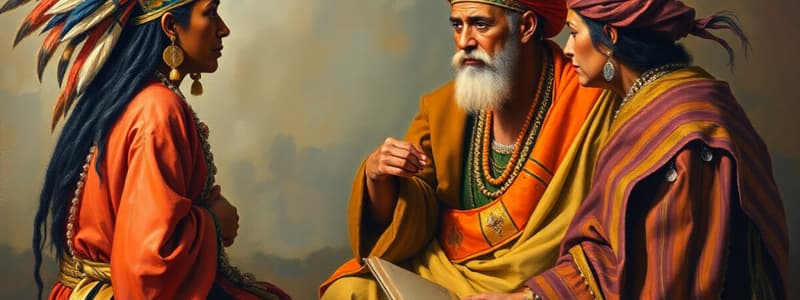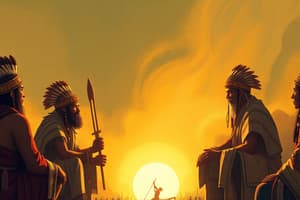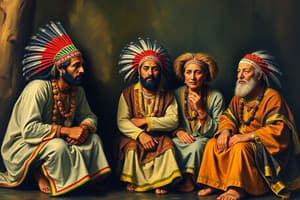Podcast
Questions and Answers
What is a fundamental aspect of Indigenous leadership?
What is a fundamental aspect of Indigenous leadership?
- Competing for resources
- Establishing strict hierarchies
- Service to the community (correct)
- Pursuit of personal power
What role do Elders play in Indigenous leadership?
What role do Elders play in Indigenous leadership?
- They have no specific role.
- They act as teachers and role models. (correct)
- They serve as political leaders.
- They enforce community rules.
Which of the following best represents the cultural foundations of Indigenous leadership?
Which of the following best represents the cultural foundations of Indigenous leadership?
- Strict adherence to modern business practices
- Individual achievement and competition
- Holistic integration of spiritual and physical dimensions (correct)
- Revitalization of urban living
Which pedagogical component involves learning about land history and practices?
Which pedagogical component involves learning about land history and practices?
What is the purpose of storywork in Indigenous leadership?
What is the purpose of storywork in Indigenous leadership?
What type of training does the Longhouse Leadership Program provide?
What type of training does the Longhouse Leadership Program provide?
Which principle is emphasized in the storytelling aspect of Indigenous leadership?
Which principle is emphasized in the storytelling aspect of Indigenous leadership?
Which of the following is NOT a component of Indigenous leadership?
Which of the following is NOT a component of Indigenous leadership?
What do stories help leaders to recognize about their roles?
What do stories help leaders to recognize about their roles?
How do stories facilitate personal growth for leaders?
How do stories facilitate personal growth for leaders?
What is a key aspect of relational leadership emphasized in storytelling?
What is a key aspect of relational leadership emphasized in storytelling?
What is a key characteristic of resonant leaders?
What is a key characteristic of resonant leaders?
What role do Elders play in the context of stories and leadership?
What role do Elders play in the context of stories and leadership?
What impact does the Positive Emotional Attractor (PEA) have on individuals?
What impact does the Positive Emotional Attractor (PEA) have on individuals?
Which quality of leadership is highlighted through storytelling?
Which quality of leadership is highlighted through storytelling?
How do emotions influence decision-making according to the content?
How do emotions influence decision-making according to the content?
In what way do stories function as tools for healing?
In what way do stories function as tools for healing?
What role do positive emotions play in leadership effectiveness?
What role do positive emotions play in leadership effectiveness?
What essential principle do stories embody that aids leaders in their practices?
What essential principle do stories embody that aids leaders in their practices?
What is the effect of positive inspiration on the brain's networks?
What is the effect of positive inspiration on the brain's networks?
What aspect of storytelling makes leadership concepts easily understandable?
What aspect of storytelling makes leadership concepts easily understandable?
What happens when positive emotions are aroused in a team?
What happens when positive emotions are aroused in a team?
Which statement about negative emotional attractors (NEA) is true?
Which statement about negative emotional attractors (NEA) is true?
What is crucial for maintaining a balance between PEA and NEA in coaching?
What is crucial for maintaining a balance between PEA and NEA in coaching?
What is a potential challenge of recognizing employee contributions?
What is a potential challenge of recognizing employee contributions?
How does empathetic leadership enhance employee engagement?
How does empathetic leadership enhance employee engagement?
What impact did Bob Chapman’s leadership style have on organizational performance?
What impact did Bob Chapman’s leadership style have on organizational performance?
What is one way empathy contributes to workplace culture?
What is one way empathy contributes to workplace culture?
What risk comes from overly recognizing small actions among employees?
What risk comes from overly recognizing small actions among employees?
What is a consequence of fostering trust and collaboration in an organization?
What is a consequence of fostering trust and collaboration in an organization?
How does empathetic leadership affect long-term stability in a workforce?
How does empathetic leadership affect long-term stability in a workforce?
What approach can help enhance employee morale in the workplace?
What approach can help enhance employee morale in the workplace?
What is one key strength of the proposed servant leadership model in Canadian policing?
What is one key strength of the proposed servant leadership model in Canadian policing?
Which of the following is a potential challenge to implementing the servant leadership model in police agencies?
Which of the following is a potential challenge to implementing the servant leadership model in police agencies?
How does the servant leadership model address workplace issues in policing?
How does the servant leadership model address workplace issues in policing?
What does humility emphasize in the context of team dynamics?
What does humility emphasize in the context of team dynamics?
What aspect of servant leadership is particularly appealing to younger generations?
What aspect of servant leadership is particularly appealing to younger generations?
What is the main idea behind personal responsibility within a team?
What is the main idea behind personal responsibility within a team?
Which of the following is NOT a strength of the servant leadership model as proposed?
Which of the following is NOT a strength of the servant leadership model as proposed?
How does the concept of 'team over individual' manifest in the All Blacks' philosophy?
How does the concept of 'team over individual' manifest in the All Blacks' philosophy?
What is a likely outcome of implementing the servant leadership model in Canadian policing?
What is a likely outcome of implementing the servant leadership model in Canadian policing?
What cultural change does the servant leadership model aim to support within police organizations?
What cultural change does the servant leadership model aim to support within police organizations?
What does 'sweeping the sheds' symbolize in achieving excellence?
What does 'sweeping the sheds' symbolize in achieving excellence?
What is the significance of recognizing the legacy and respect in team culture?
What is the significance of recognizing the legacy and respect in team culture?
Why is servant leadership considered an attractive option for police organizations?
Why is servant leadership considered an attractive option for police organizations?
What does the practice of small actions signify in the context of character and integrity?
What does the practice of small actions signify in the context of character and integrity?
What role does the 'water carrier' play in the team according to the leadership theory?
What role does the 'water carrier' play in the team according to the leadership theory?
What perception did Cantona have about Deschamps' role as a 'water carrier'?
What perception did Cantona have about Deschamps' role as a 'water carrier'?
Flashcards
Stories Model Leadership
Stories Model Leadership
Elders use stories from real life to show good leadership qualities and cultural teachings.
Holistic Learning in Stories
Holistic Learning in Stories
Stories teach leaders to see the connections between people, communities, and nature.
Stories Promote Healing
Stories Promote Healing
Stories help people heal from trauma by connecting them to their culture and shared experiences.
Relational Leadership in Stories
Relational Leadership in Stories
Signup and view all the flashcards
Intergenerational Wisdom
Intergenerational Wisdom
Signup and view all the flashcards
Stories make concepts tangible
Stories make concepts tangible
Signup and view all the flashcards
Leadership Qualities from Stories
Leadership Qualities from Stories
Signup and view all the flashcards
Good Life Path in Stories
Good Life Path in Stories
Signup and view all the flashcards
Resonant Leaders
Resonant Leaders
Signup and view all the flashcards
Dissonant Leaders
Dissonant Leaders
Signup and view all the flashcards
Positive Emotional Attractor (PEA)
Positive Emotional Attractor (PEA)
Signup and view all the flashcards
Negative Emotional Attractor (NEA)
Negative Emotional Attractor (NEA)
Signup and view all the flashcards
Emotional Arousal & Cognition
Emotional Arousal & Cognition
Signup and view all the flashcards
Leadership Impact on Decision-Making
Leadership Impact on Decision-Making
Signup and view all the flashcards
Positive Emotions & Leadership Effectiveness
Positive Emotions & Leadership Effectiveness
Signup and view all the flashcards
Why Lead with Positive Inspiration?
Why Lead with Positive Inspiration?
Signup and view all the flashcards
Empathy in Leadership
Empathy in Leadership
Signup and view all the flashcards
Trust and Collaboration
Trust and Collaboration
Signup and view all the flashcards
Employee Morale and Engagement
Employee Morale and Engagement
Signup and view all the flashcards
Improving Organizational Performance
Improving Organizational Performance
Signup and view all the flashcards
Positive Workplace Culture
Positive Workplace Culture
Signup and view all the flashcards
Building Long-Term Stability
Building Long-Term Stability
Signup and view all the flashcards
What is Recognition?
What is Recognition?
Signup and view all the flashcards
Challenges of Recognition
Challenges of Recognition
Signup and view all the flashcards
Indigenous Leadership
Indigenous Leadership
Signup and view all the flashcards
Role of Elders
Role of Elders
Signup and view all the flashcards
Cultural Foundations
Cultural Foundations
Signup and view all the flashcards
Land Interaction
Land Interaction
Signup and view all the flashcards
Storywork
Storywork
Signup and view all the flashcards
Longhouse Leadership Program
Longhouse Leadership Program
Signup and view all the flashcards
Cultural Practices in Leadership
Cultural Practices in Leadership
Signup and view all the flashcards
Community Service Leadership
Community Service Leadership
Signup and view all the flashcards
Servant Leadership in Policing
Servant Leadership in Policing
Signup and view all the flashcards
Alignment with Policing Ethos
Alignment with Policing Ethos
Signup and view all the flashcards
Cultural Change Focus
Cultural Change Focus
Signup and view all the flashcards
Appeal to Modern Workforce
Appeal to Modern Workforce
Signup and view all the flashcards
Restoring Public Trust
Restoring Public Trust
Signup and view all the flashcards
Organizational Resistance
Organizational Resistance
Signup and view all the flashcards
Transforming Cultural Norms
Transforming Cultural Norms
Signup and view all the flashcards
Humility in Action
Humility in Action
Signup and view all the flashcards
Personal Responsibility
Personal Responsibility
Signup and view all the flashcards
Team Over Individual?
Team Over Individual?
Signup and view all the flashcards
Discipline & Attention to Detail
Discipline & Attention to Detail
Signup and view all the flashcards
Legacy & Respect
Legacy & Respect
Signup and view all the flashcards
Water Carrier as a Leader
Water Carrier as a Leader
Signup and view all the flashcards
Why is Sweeping Important?
Why is Sweeping Important?
Signup and view all the flashcards
Star Players vs. Water Carrier
Star Players vs. Water Carrier
Signup and view all the flashcards
Study Notes
Elders' Teachings on Leadership
- Indigenous leadership is viewed as a community responsibility, emphasizing service, collaboration, and cultural values.
- Cultural values inform leadership through traditional teachings, like the "good life path," which emphasizes living with integrity, balance, and respect.
- Ceremonial practices and rituals further teach leadership principles.
- Elders guide and transmit knowledge, knowledge and values through stories, ceremonies, and mentorship.
Storywork as a Leadership Framework
- Storywork integrates respect, reciprocity, reverence, and holism in leadership development methods.
- It connects past experiences with present realities, helping leaders navigate challenges with cultural insight.
Land-Based Learning
- Leadership education involves land-based learning, understanding its history, and practicing stewardship.
- Elders share stories connecting cultural teachings to specific places, reinforcing the interconnectedness of people, land, and leadership.
Holistic Leadership Development
- Holistic leadership involves balancing physical, emotional, mental, and spiritual well-being.
- Healing and transformation are essential components of Indigenous leadership.
Language and Genealogy
- Indigenous languages and genealogies are central to leadership development.
- Acknowledging territory is a critical part of respecting Indigenous peoples and their lands.
Leadership as a Lifelong Journey
- Intergenerational learning is core to Indigenous leadership.
- Flexibility and adaptability are encouraged, valuing traditional values whilst reflecting on personal journeys.
- Leadership is a continual process of learning over time.
- Decolonization and Resistance are key aspects of Indigenous leadership.
Leadership as a Gift
- Leadership is viewed as a sacred responsibility, requiring humility, dedication, and alignment with cultural teachings.
- It is about empowering others and ensuring the sustainability of Indigenous knowledge and practices.
Role of the Community
- Leadership is a community service, emphasizing reciprocity and well-being.
- Leaders work with their communities to address issues, making decisions with community input and prioritizing community needs.
Leadership Through Collaboration
- Emphasis on diverse voices and inclusion in decision-making.
- Combining Elders with the contributions of adults and youth to share knowledge and ideas.
Building Respectful Relationships
- Respectful relationships are pivotal in Indigenous leadership.
- Restoring relationships, addressing the impacts of colonialism is important to modern Indigenous leadership.
- Collaborative, community-based leadership is vital.
Community as a Source of Knowledge
- Communities offer repositories of cultural knowledge, traditions, and histories.
- Elders, as community representatives, play a key role in knowledge transmission through stories, ceremonies, and mentorship.
Leadership as a Collective Responsibility
- Emphasizes the shared responsibility of leadership within the community.
- Prioritizes collective well-being over personal ambition.
- Community guides leaders in decision-making that aligns with shared values and goals.
Ensuring Cultural Continuity
- Communities play a key role in maintaining Indigenous cultural practices and knowledge.
- The transmission of cultural values and traditions within the community shapes leadership.
Stories and Leadership
- Stories serve as a means to pass down traditions, histories and values across generations.
- Elders use stories to teach important leadership principles such as respect, responsibility, and relational accountability.
- Stories help connect individuals to their communities, the land and their cultural heritage.
- Storywork as a framework for creating deeper understandings for leadership development.
Emotional Contagion
- Emotions spread unconsciously in milliseconds, influencing the emotional states of others.
- Negative emotions impair cognitive processes (e.g., creativity, learning)
- Positive Emotions enhance well-being, cognitive openness, and neurogenesis.
- Leaders' emotional states directly influence their teams.
Leadership as Gift and Responsibility
- Service to the community and rooted in respect, responsibility, reverence, and relationship.
- Leaders are accountable for the well-being of their community and future generations.
Leadership as Relational
- Focuses on building respectful relationships with individuals, the land, and the community.
- Reciprocity and collaboration are essential for effective leadership.
Decolonization and Resilience
- Reclaiming Indigenous cultural values and resisting colonialism and its legacies.
Intergenerational Knowledge
- Leadership strengthened by knowledge transfer across generations.
Holistic Leadership
- Leadership that integrates cultural, spiritual, and ecological knowledge. Focuses on promoting balance and well-being.
Contingency Theories
- Leadership effectiveness depends on context and situation.
- Leader-Member Exchange (LMX) focuses on relationships within groups.
- Path-Goal Theory outlines four leadership styles.
- Theory X and Y describe different employee motivational styles.
- Situational leadership involves adapting leadership styles to various situations.
- Transformational Leadership inspires and elevates followers.
Instinct and Intuition
- Integrating experience with judgment for decisions.
- Managing change by reframing fear as opportunity. Utilizing motivation through connections to relationships.
- The role of "soft skills" and experience in effective leadership
Servant Leadership
- Prioritizes serving and empowering others.
- Focuses on followers' growth and well-being.
- Rejects transactional approaches in favor of genuine relationships.
- Values equality, inclusivity, and community
Leadership Styles
- Describes various leadership styles like Coercive, Authoritative, Affiliative, Democratic, Pacesetting, and Coaching.
- Discusses strengths and weaknesses of each style.
Leadership in Culture and Identity
- Shared beliefs, values, and assumptions that shape behaviors.
- Discusses cultural challenges for women.
Understanding Cultural Differences
- Discusses similarities and differences in cultural expectations and norms impacting leadership.
- Discusses the importance of empathy and cultural awareness in leadership.
Studying That Suits You
Use AI to generate personalized quizzes and flashcards to suit your learning preferences.




